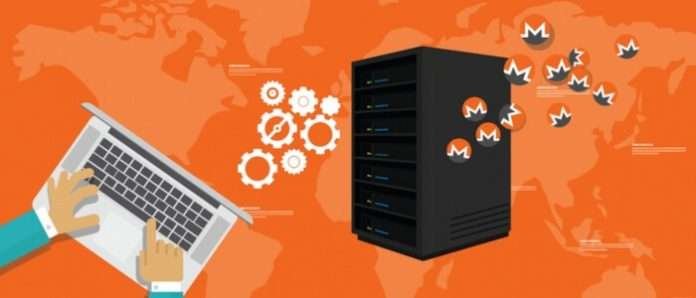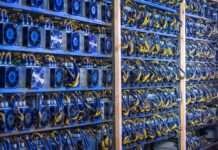
Cryptocurrency mining is creating new occupations.
Although the hardware to mine leading currencies such as Bitcoin, Litecoin and Ethereum can be expensive, Monero mining provides a less expensive option that still has the potential to yield a handsome return on your investment.
Mining Monero coins is a great way to subsidise your initial investment. All you need is a personal computer, preferably with a high-end AMD or GPU.
This article will explain how to mine Monero and the equipment you need to get started.
As we work through the whys and wherefores, you will also have the opportunity to decide whether mining Monero is a good option for you.
Monero Coin Explained

Monero (XMR) is a digital currency that uses an algorithm designed to increase the security of making online transactions. The currency relies on Ring Signatures that provide users with a high level of privacy when making a transaction through the internet.
Monero is also a ‘proof-of-work’ token which can be mined. Miners that successfully seal the blockchain with a hash are rewarded. The current rate is around 7 XMR minus transaction fees and pool mining subscriptions. There are several Monero mining calculators you can use to work out how much you can expect to earn.
But the best news for newcomers to cryptocurrency mining is you can still mine Monero with a CPU, GPU or both. At the time of writing, there are no application-specific integrated servers (ASIC’s) that centralise the mining process, which means anyone with a computer can learn how to mine Monero.
For more details about Monero, visit our guide to the Monero Coin.
Why Mine Monero Coins?
Monero is a privacy-focused cryptocurrency and, at the time of writing is trading at $352.63 pitching into the top ten digital coins on the market.
Given Monero is tipped to hold its position among the leading cryptocurrencies moving forward, there is plenty of potential to earn a significant profit mining Monero in 2018.
Monero’s greatest strength is that its algorithm is resistant to ASIC mining that Bitcoin and other virtual currencies use. This means there is less competition from miners that have powerful rigs they can use to their advantage.
Monero miners are still advised to join a Monero mining pool as you increase your chances of earning a steady stream of income that is difficult to achieve when mining solo.
The advantages of mining Monero coins:
- XMR can be traded for bitcoin so is an effective way to build a portfolio of BTC
- BTC can be exchanged for fiat currencies, so mining XMR is a stepping-stone to making a profitable income in your local currency
- Mining Monero is affordable compared with many other leading cryptocurrencies – the entry-level is relatively low-cost, yet users still have the potential to make high returns
- Mining XMR uses less electricity than other coins so keeps overheads to a minimum
Prospects of Mining Monero
The earlier you join the community of Monero miners, the more potential you have of profiting.
Since Monero entered the DarkNet in 2016, the value of the token has soared. Despite this, other miners are investing in powerful rigs to focus their attention on Bitcoin and other altcoins.
Meanwhile, anybody with an ordinary computer has the opportunity to enter a low-risk venture.
The majority of investors adding cryptocurrencies to their investment portfolio sit and wait for the choice of coin to rally its price point. In the interim, the price will go up and down. The risk with any cryptocurrency is the price may stay down, and investors miss out on earning profits and potentially lose their investment altogether.
Investors that opt for Monero can earn more money while they bide their time and wait for the right moment to sell.
Investing in cryptocurrency mining gear provides you with an incoming-producing asset which has the potential to earn more than the profit margins you make on the actual coin – unless Monero explodes.
Monero Mining vs Bitcoin Mining
Source: CoinSutra
Bitcoin mining is an oversaturated market.
Established firms that have been mining bitcoin for years have built high-powered computers that make it impossible for newcomers to compete against unless you have enough upfront capital that can build a rig to compete with the best. Your Windows PC or Mac is not going to cut it.
As a result of the monopoly in Bitcoin mining, firms with smaller rigs created mining pools. Such schemes involve a group of miners pooling their resources to increase the power of their mining capabilities.
Mining Monero will still involve joining a mining pool, but users can join with an average (or preferably top-end) desktop computer rather than having to invest in expensive hashing hardware (ASICs).
Monero uses a memory-hard hashing algorithm called Cryptonight which makes it immune to Bitcoin ASICs. The algorithm is specifically designed to operate with a CPU or GPU thus offer miners that only have an average rig the capability of earning from your mining efforts.
XMR also has a built-in privacy protocol which can compete with other leading coins such as Dash and Zcash that prioritise privacy as a business model.
The lack of privacy during a Bitcoin transaction is one of the currencies biggest failures. The most alarming aspect of this is that anybody with access to the Bitcoin network can see how much Bitcoin you have in your wallet.
For Bitcoin owners with a substantial stash, the lack of privacy is problematic as they are more likely to be targeted by cybercriminals. Hacking a personal PC or infecting it with malicious malware is not that difficult to do for professionals. Not only that, if traders or competitors know how much a business is worth, it could compromise future negotiations.
The Bitcoin community has attempted to resolve these issues by introducing ‘mixing’ features, but so far the solutions have been nothing more than a band-aid. The cryptocurrencies that harbour the best prospects of becoming a mainstream currency are blockchains that assure the privacy of users.
Another advantage cryptocurrencies need to offer users is the speed of transactions.
The Monero algorithm is capable of mining blocks far quicker than Bitcoin’s. The average block is hashed in two minutes with Monero – five times faster than Bitcoin that on average takes 10 minutes.
What Hardware Do You Need to Mine Monero?

The bare minimum you need to mine Monero is a desktop computer and an AMD card. You can mine Monero on Windows, Mac or Linux and ideally have nothing less than an i5 or i7 processor.
If your computer is not already fitted with an Intel or AMD chip, you will need to install one.
To give your rig more power, you can also install and Graphics Processing Unit (GPU such as Nvidia video card). GPU’s work well for some altcoins although for Monero, AMD is the stronger performer.
The best AMD’s to mine Monero are:
- Rx 470/480
- Rx 570/580
- AMD R9 range
- HD 7990/7950
What Software Do You Need to Mine Monero?
Historically, the best software for mining Monero is MinerGate. The software is easy to download and install.
More recently, XMR Stak released an update that allows users to download the software directly from the internet. Make sure you only download mining software from the brand’s official website as it is easy to install malicious malware on fake applications.
Before you can use cryptocurrency mining software, you need to register for an account.
Accounts with MinerGate and XMR Stak are free. Before you download the software make sure you select the compatible option for your computer; Mac, Windows or Linux.
After downloading the software, you will need to enter the email address you used to register for an account to activate the software and install it on your PC. After that, installation is self-explanatory, although some Firewalls block mining software.
If you do encounter problems while setting up the application, refer to this tutorial for MinerGate or this tutorial for XMR Stak.
Both MinerGate and XMR Stak are simple to install, and the interfaces are user-friendly. Furthermore, and most importantly, both programs add sufficient hashing power to desktop computers and have a proven record of yielding good results.
Monero Mining Pools
When you mine Monero or any other cryptocurrency, you need to decide whether to mine solo or join a mining pool.
For miners with a basic setup on a desktop computer, it is recommended to join a mining pool as you will have a more realistic chance of hashing blockchains and being rewarded with XMR.
Unless you intend to set up a business and have the capital invested in a robust computer rig, joining a mining pool is the only option. Otherwise, you will be wasting your time and the little bit of money you have invested in setting your home computer up as a means of making money.
Joining a mining pool increases your chances of winning rewards on a more regular basis, but also means you have to share the profits.
When you work solo, you receive the entire reward of 7 XMR. Working as part of a mining pool you will only get a fraction of the 7 XMR. The actual amount you make will depend on how much you have power and work you contribute to securing the blockchain.
The advantage a mining pool offers is you are more likely to make a profit. Mining pools work by a group of contributors that pool their resources to increase the power and work rate of their hashing equipment.
This increases the chances of sealing a blockchain and winning the reward. It may still be possible to seal blockchains by working on your own, but getting rewards takes much longer.
When you install the mining software, you will be asked if you want to join a mining pool. If you do, enter the pool address in your software. Before selecting mining, pool do your due diligence.
Mining pools charge fees of between 1% and 10% and have varying degrees of success.
Before choosing a mining pool, research user forums and get the skinny on how effective the mining pool is. What you want to know is whether the pool provides you with a consistent income that justifies the subscription fee.
The best pools for mining Monero are:
MineXMR
- Servers in France, Germany, Canada
- 1% Pool Fee
- ~25,000 Connected Users
- 0.5XMR Minimum Payout
Nanopool
- Servers in: Europe (2), US East, US West, Asia
- 1% Pool Fee, and Payout Commission of 0.015XMR
- ~5000 Connected Users
- 1XMR Minimum Payout
Dwarfpool
- Servers in: Europe, USA
- 1.5% Pool Fee, and Payout Commission of 0.014XMR for exchange wallets, or 0.008XMR for regular wallets
The Best Monero Wallets
Source: HashGains
Before you invest or mine cryptocurrency, you will need a wallet that is compatible with Monero XMR.
Cryptocurrency wallets are the best way to store your cryptocurrency securely. They are available in several formats, namely, detachable devices, desktop wallets, cloud wallets, mobile wallets and paper wallets.
The most secure, and thus the best options are the detachable hardware wallets. These typically come in the form of a USB memory stick that is designed explicitly to bank cryptocurrencies. The best hardware wallets have two-way authentication that includes a privacy code and a personal passphrase.
It is also recommended that you make a paper wallet and keep it in a safe place in case you lose your hardware wallet. A paper wallet involves merely printing off your private and public keys and making a note of your passphrase or password.
Desktop wallets, cloud wallets are mobile wallets are okay if you don’t have a huge holding of tokens, but can be hacked easier than hardware wallets.
When you install the mining software, you will also be prompted to set up a wallet. If you don’t have a wallet when you first install the software, you can always go back and add the wallet ID to the application.
However, it is advisable to invest in a hardware wallet before you start mining, so you have somewhere to store your XMR.
One of the best and most affordable cryptocurrency hardware wallets for Monero is Ledger Nano S.
If you don’t want to invest in a digital wallet, the other option is to store your tokens with an established cryptocurrency exchange.
This is a reasonable option, although there is arguably more risk of your coins were stolen. There have already been three exchanges claim their systems have been hacked.
Conclusion
If you are interested in mining cryptocurrencies, Monero provides everybody with an easy gateway.
Joining a mining pool is undoubtedly more profitable than single mining as you don’t need an expensive and robust equipment – a regular computer will do the job as well.
By learning how to mine Monero, investors can double up on profit-making potential and maybe even forge yourself a new career as a cryptocurrency miner.
If you’re interested in other profitable coins to mine, check our guide to Litecoin Mining Pools.



![Bitcoin Buyer Review of Official Website [2022] bitcoin buyer review featured image](https://bitemycoin.com/wp-content/uploads/2022/04/bitcoin-buyer-review-featured-218x150.jpg)
![Bitcoin Digital | Official Website Review [2022] bitcoin digital review featured](https://bitemycoin.com/wp-content/uploads/2022/04/bitcoin-digital-featured-218x150.jpg)





